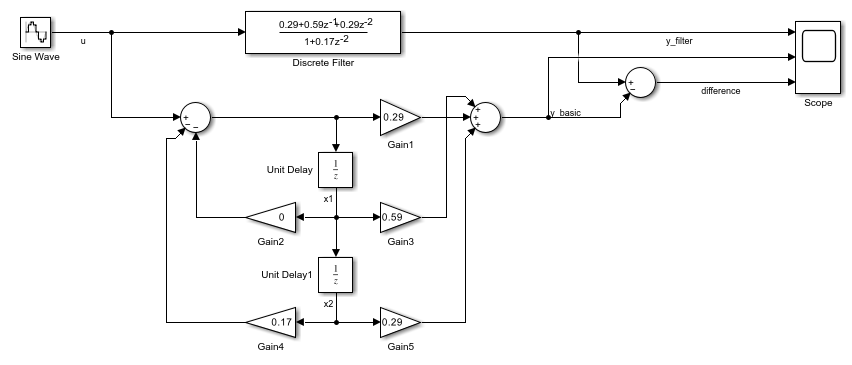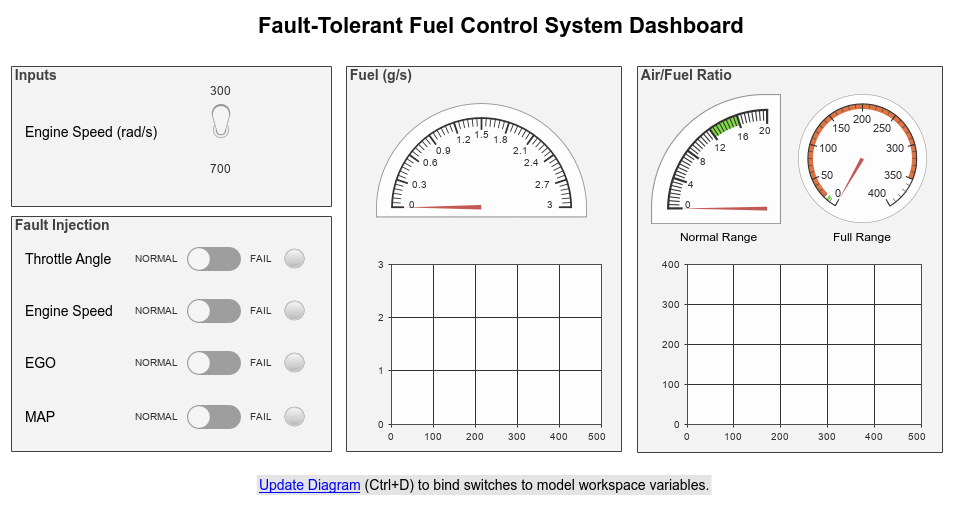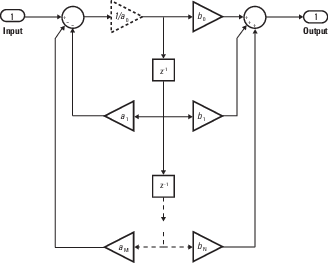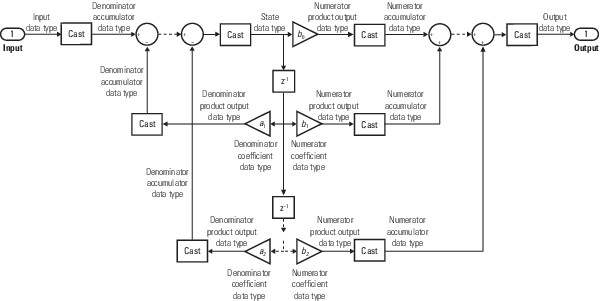Discrete Filter
构建无限冲激响应 (IIR) 滤波器模型
库:
Simulink /
Discrete
DSP System Toolbox /
Filtering /
Filter Implementations
描述
Discrete Filter 模块使用指定的数字 IIR 滤波器单独对输入信号的每个通道进行滤波。您可以将滤波器结构指定为 Direct form I、Direct form I transposed、Direct form II 或 Direct form II transposed。该模块实现了具有固定系数的静态滤波器。您可以调整这些静态滤波器的系数。
此模块随时间的推移单独对输入信号的每个通道进行滤波。输入处理参数用于指定该模块如何处理输入的每个元素。您可以指定将输入元素作为独立通道处理(基于采样的处理),或将输入的每个列作为独立通道处理(基于帧的处理)。要执行基于帧的处理,您必须拥有 DSP System Toolbox™ 许可证。
输出维度等于输入维度,但为分子系数参数指定滤波器抽头矩阵时除外。当您执行此操作时,输出维度取决于您指定的不同滤波器抽头集的数量。
使用分子系数参数可以指定离散滤波器分子多项式的系数。使用分母系数参数可以指定函数的分母多项式的系数。分母系数参数必须为系数向量。
按 z-1 的升幂顺序指定分子和分母多项式的系数。Discrete Filter 模块允许使用 z-1(延迟算子)形式的多项式来表示离散系统。信号处理工程师通常使用这种方法。反之,Discrete Transfer Fcn 模块允许使用 z 形式的多项式来表示离散系统。控制工程师通常使用这种方法。当分子和分母多项式的长度相同时,两种方法相同。
指定初始状态
在对话框参数和输入端口模式下,该模块默认将内部滤波器状态初始化为零,这等效于假定过去的输入和输出为零。您可以选择使用初始状态参数为滤波器延迟指定非零初始状态。
要确定您必须指定的初始状态值数量以及如何指定这些状态值,请参阅下面的有关有效初始状态和延迟元素数(滤波器状态)的表。初始状态参数可采用下表所述的四种形式之一。
有效初始状态
| 初始状态 | 示例 | 描述 |
|---|---|---|
| 标量 |
每个通道的每个延迟元素均设置为 | 模块将滤波器中的所有延迟元素初始化为标量值。 |
| 向量 | 用于具有两个延迟元素的滤波器:[d1 d2] 所有通道的延迟元素均为 d1 和 d2。 | 每个向量元素均为相应的延迟元素指定一个唯一的初始条件。模块将相同的初始条件向量应用于输入信号的每个通道。向量长度必须等于滤波器中的延迟元素数(在表延迟元素数(滤波器状态)中指定)。 |
| 向量或矩阵 | 对于三通道输入信号和具有两个延迟元素的滤波器: [d1 d2 D1 D2 d1 d2] 或
| 每个向量或矩阵元素均为相应通道中的相应延迟元素指定唯一的初始条件:
|
| 空矩阵 |
| 空矩阵 |
每输入通道的延迟元素数取决于滤波器结构,如下表所示。
延迟元素数(滤波器状态)
| 滤波器结构 | 每通道的延迟元素数 |
|---|---|
| 直接 I 型 |
|
| 直接 II 型 |
|
下表根据您将输入处理参数设置为基于帧还是基于采样,分两种情况说明采用不同输入大小和不同通道数时的有效初始状态。
基于帧的处理
| 输入 | 通道数 | 有效初始状态(对话框) | 有效初始状态(输入端口) |
|---|---|---|---|
| 1 |
|
|
| N |
|
|
基于采样的处理
| 输入 | 通道数 | 有效初始状态(对话框) | 有效初始状态(输入端口) |
|---|---|---|---|
| 1 |
|
|
| N |
|
|
| K×N |
|
|
当初始状态为标量时,模块将所有滤波器状态初始化为相同的标量值。输入 0 可将所有状态初始化为零。当初始状态为向量或矩阵时,每个向量或矩阵元素都指定一个唯一的初始状态。此唯一状态对应于相应通道中的一个延迟元素:
向量长度必须等于滤波器中的延迟元素数,
M = max(number of zeros, number of poles)。矩阵的行数必须与滤波器中的延迟元素数相同,
M = max(number of zeros, number of poles)。矩阵的每一列还须对应输入信号的一个通道。
初始滤波器输出 y1、初始输入 u1 和初始状态 [x1, x2] 之间的关系如以下方程所示。
其中
b1、b2 和 b3 是离散滤波器的分子系数。
a1、a2 和 a3 是离散滤波器的分母系数。
示例
扩展示例
端口
输入
输出
参数
详细信息
扩展功能
版本历史记录
在 R2006a 之前推出另请参阅
模块
- Discrete FIR Filter | Allpole Filter (DSP System Toolbox) | Digital Filter Design (DSP System Toolbox)
函数
dsp.IIRFilter(DSP System Toolbox) |dsp.AllpoleFilter(DSP System Toolbox) |filterDesigner(DSP System Toolbox) |fvtool(Signal Processing Toolbox)
主题
- Sample- and Frame-Based Concepts (DSP System Toolbox)
- 使用状态





